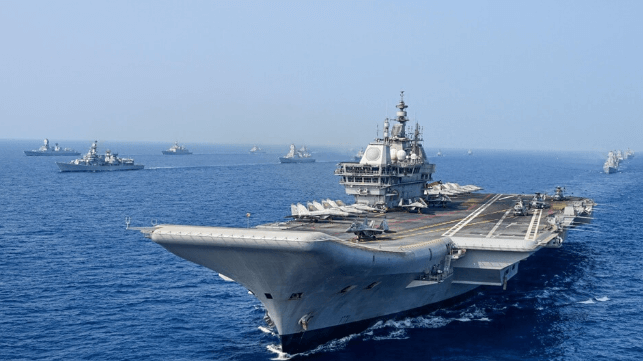Top Admiral Says India Was Prepared to Strike Port of Karachi
The statement follows a new and so far successful ceasefire agreement brokered by the U.S.

On Saturday, just at the point when the conflict between India and Pakistan was threatening to escalate out of control, the United States brokered an immediate ceasefire between the two nuclear armed countries. The agreement was still holding as of midday Sunday, despite small-scale violations, and leaders from both sides have claimed victory.
The war between India and Pakistan had escalated significantly on Friday, with both sides conducting attacks deep across the border between them, focused primarily on air bases. Open warfare between the two nations followed Indian attacks on nine sites in Pakistani-controlled Kashmir early on May 7, which India said was a response to the terrorist attack in Indian-controlled Kashmir on April 22, in which 26 tourists were killed.
The conflict has been characterized by a particularly acute media war, with mainstream and social media on both sides putting out false stories, apparently not only in a bid to win favorable world opinion but also for the purposes of operational deception. Hence, media reporting coming from the region needed to be treated with extreme caution, with some open-source reporters steering clear for fear of spreading planted stories.
The first attacks were largely confined to exchanges across the Line of Control within disputed Kashmir and India claiming to be hitting only what it considered to be terrorist-associated targets. These attacks intensified, with both sides then attacking military targets well beyond Kashmir itself.
Overnight May 9, both sides were using airstrikes, missiles and drones. A number of Pakistani airfields were hit, including in Lahore and the Nur Khan airbase in Rawalpindi, which houses the Joint Services Headquarters, the Pakistani Armed Forces entity directing operational activity. Heat signatures from the attack on the headquarters in Rawalpindi were visible in NASA’s FIRMS satellite imagery.
All Pakistani airspace was closed to civilian flights. Indian spokesman Colonel Sofiya Qureshi acknowledged that Pakistan had attacked 26 targets in India overnight, including Indian airbases in Udhampur, Bhuj, Pathankot, and Bathinda.
Both sides had been moving ground forces forward into the Kashmir area, with India having mobilized reserve units from its Territorial Army.
India & Pakistan issue multiple notifications for simultaneous naval firing exercises across various zones in the Arabian Sea
— Damien Symon (@detresfa_) May 8, 2025
Dates
08 - 13 May 2025 (IND)
09- 12 May 2025 (PAK) pic.twitter.com/KeKJ1rapWg
Both India and Pakistan issued Notice to Mariner declarations giving notice of live firing exercises within their Exclusive Economic Zones, with the pattern of these declared no-entry zones suggesting that the Pakistani Navy has pulled back to deployment areas closer to its coastline.
There have as yet been no reports of any exchanges at sea. Given the escalatory trajectory of the conflict, it appears that naval clashes would have been the next escalatory step for both sides. India is likely to have attempted to replicate the success of its Operation Talwar blockade of Karachi, Pakistan’s main commercial port, which starved Pakistan of fuel and had a decisive impact of the conflict between the two nations in 1999.
Indeed, India’s navy confirmed Sunday that it positioned its warships to strike Pakistani territory if needed, and that one of the potential targets was - and still could be, if hostilities resume - the port city of Karachi.
“On 22nd April, the Indian Navy's Carrier battle group, surface forces, submarines and aviation assets were immediately deployed at sea with full combat readiness,” said Vice Admiral AN Pramod at a press conference Sunday. “Our forces remained forward deployed in the Northern Arabian Sea in a decisive and deterrent posture with full readiness and capacity to strike select targets at sea and on land, including Karachi, at a time of our choosing.”
The Indian Navy is likely to have deployed a forward submarine screen covering approaches to Karachi, using carrier-launched aircraft from INS Vikrant (R11) and INS Vikramaditya (R33) to curb Pakistani maritime surveillance efforts with their P-3 aircraft. The Pakistani submarine force, which is proud of successful attacks on the Indian frigates INS Khukri (F149) and INS Kirpan (F144) in the 1971 war, will have attempted to cover the movements of these aircraft carriers.
It is not known if the Indian Navy has yet deployed any BrahMos extended-range anti-ship missiles, which it ordered last year; but with a 500 mile range, these missiles would have given the Indian Navy a significant tactical advantage in naval engagements. As reflected in the issuance of Notice to Mariners, the Pakistanis are likely to have kept their ships close in to the coast, so as to enjoy better protection from Pakistan's land-based air defense sites.
